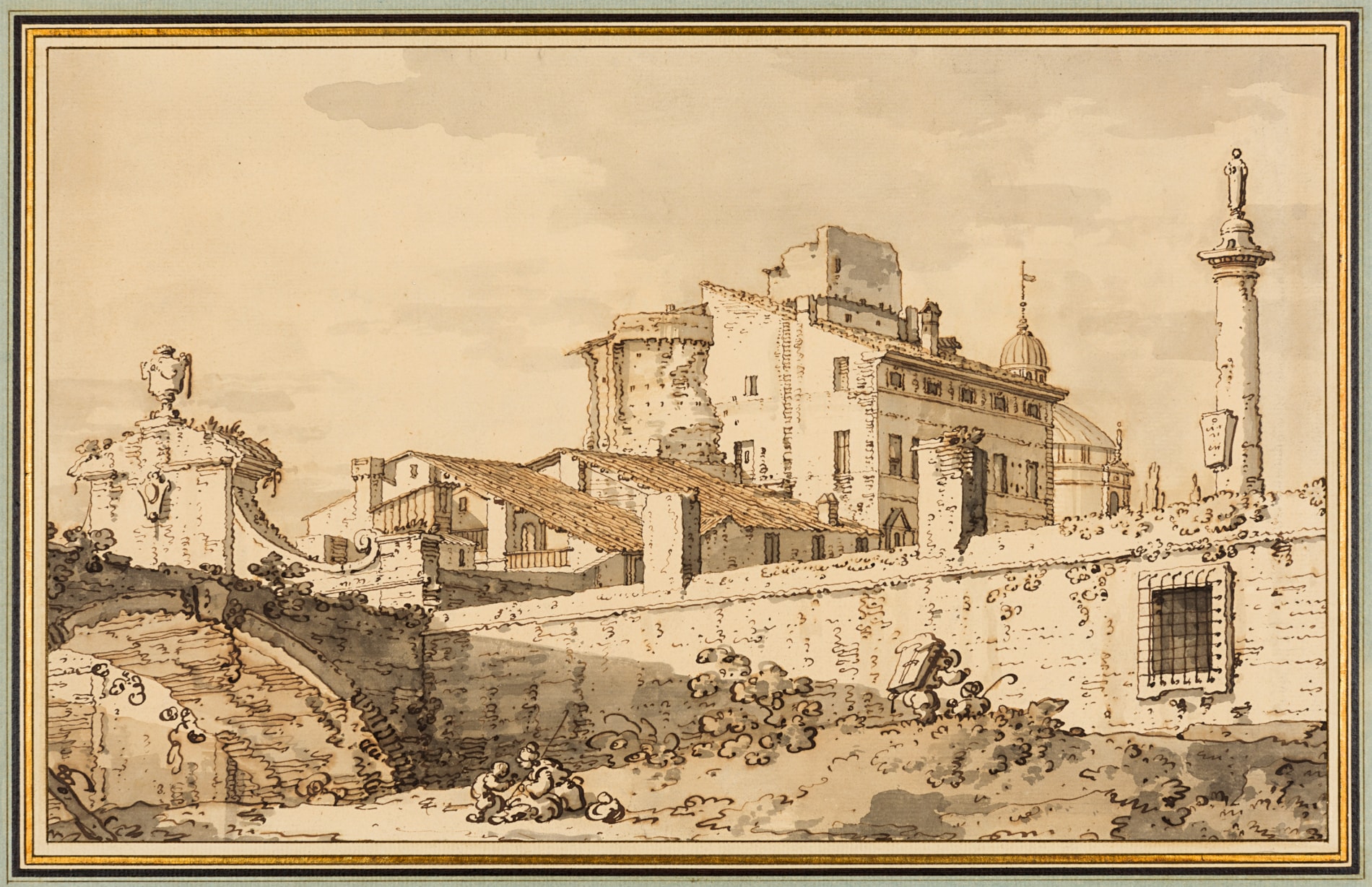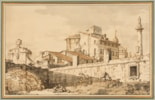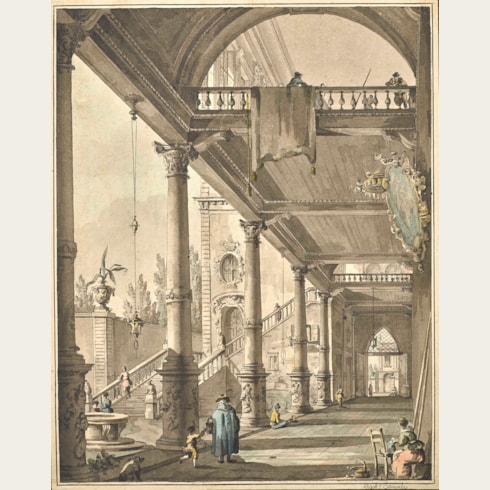Giovanni Antonio Canal, CANALETTO
(Venice 1697 - Venice 1768)
An Architectural Capriccio
Sold
Pen and brown ink and brown and grey wash, over traces of an underdrawing in graphite.
211 x 339 mm. (8 1/4 x 13 3/8 in.)
211 x 339 mm. (8 1/4 x 13 3/8 in.)
Previously unpublished and little known to scholars, this splendid veduta ideate, or imaginary view, is a particularly fine and fresh example of Canaletto’s refined draughtsmanship at the height of his career. Such drawings of purely invented scenes begin to occur in his oeuvre during the late 1730s and early 1740s, at about the same time that he turned his attention towards such subject matter in his paintings and etchings. From then until the end of his life, drawings of fanciful views occur more and more frequently, and such refined drawings as the present sheet may be dated to the artist’s maturity. In this drawing - unlike the other type of architectural capricci drawings in which Canaletto took actual buildings and placed them in new and often unusual settings - the composition is one invented by the artist, creating a picturesque scene without any specific reference to actual topography. Yet, as Joseph Links has pointed out, ‘Even the non-architectural imaginary views have some buildings in them; Canaletto could not have painted or drawn a truly rural scene such as Marco Ricci or [Francesco] Zuccarelli took in their stride…It is not surprising that an artist normally so concerned with reality should sometimes have felt an urge to escape from it, and Canaletto seems to have indulged the whim on occasion from the beginning to the end of his career.’ Even in such imagined scenes, however, the artist maintained his habitual practice, as a draughtsman, of carefully constructing his compositions with a pencil underdrawing, over which are applied more freely drawn lines in pen and ink.
Datable to the early 1740s, the present sheet is closely related to a slightly larger variant of the same composition, with several significant differences, in a private collection in New York. As has been noted of that drawing, ‘In his mature years Canaletto made a specialty of such architectural capricci, in which he crowded together buildings of the most disparate nature, transforming monuments he had seen in Venice, Rome, and England. Here the buildings are largely of Venetian inspiration, though the triumphal column at right is surely a Roman recollection.’ Both the present sheet and that in New York are in turn related to a small capriccio oil painting by Canaletto, probably slightly later in date, in the collection of the Earl Cadogan in Perthshire, Scotland.
This exceptional pen and wash drawing, in superb condition, may be grouped with other stylistically and thematically comparable drawings of the veduta ideata type by Canaletto such as a view of Houses by a Porch in the Kupferstichkabinett in Berlin, two drawings of a Watermill Near a Ruined Tower by a Stream and a Hill with a Village Street Leading Past a Church in the Victoria and Albert Museum in London, a Lagoon Capriccio with a Church, Tower and a Bridge in the Metropolitan Museum of Art in New York, a Capriccio with a Lock Gate on a River in the Städel Museum in Frankfurt and a House and Fountain Adjoining a Ruined Arch in the Royal Collection at Windsor. As W. G. Constable has noted, these pen and wash drawings ‘have [a] distinctive character…elaborately composed, full of detail put in with a mannered though lively touch, and are in a high key without strong contrasts of light and shade...the different groups of drawings produced by Canaletto in the earlier forties…makes clear the remarkable range and variety of his work at this period, and emphasizes how much his attention was concentrated upon the graphic arts, to some extent dwarfing his activities as a painter.’
Datable to the early 1740s, the present sheet is closely related to a slightly larger variant of the same composition, with several significant differences, in a private collection in New York. As has been noted of that drawing, ‘In his mature years Canaletto made a specialty of such architectural capricci, in which he crowded together buildings of the most disparate nature, transforming monuments he had seen in Venice, Rome, and England. Here the buildings are largely of Venetian inspiration, though the triumphal column at right is surely a Roman recollection.’ Both the present sheet and that in New York are in turn related to a small capriccio oil painting by Canaletto, probably slightly later in date, in the collection of the Earl Cadogan in Perthshire, Scotland.
This exceptional pen and wash drawing, in superb condition, may be grouped with other stylistically and thematically comparable drawings of the veduta ideata type by Canaletto such as a view of Houses by a Porch in the Kupferstichkabinett in Berlin, two drawings of a Watermill Near a Ruined Tower by a Stream and a Hill with a Village Street Leading Past a Church in the Victoria and Albert Museum in London, a Lagoon Capriccio with a Church, Tower and a Bridge in the Metropolitan Museum of Art in New York, a Capriccio with a Lock Gate on a River in the Städel Museum in Frankfurt and a House and Fountain Adjoining a Ruined Arch in the Royal Collection at Windsor. As W. G. Constable has noted, these pen and wash drawings ‘have [a] distinctive character…elaborately composed, full of detail put in with a mannered though lively touch, and are in a high key without strong contrasts of light and shade...the different groups of drawings produced by Canaletto in the earlier forties…makes clear the remarkable range and variety of his work at this period, and emphasizes how much his attention was concentrated upon the graphic arts, to some extent dwarfing his activities as a painter.’
A pupil of his father Bernardo, a theatrical designer, Canaletto began his career as a scenographic painter before turning his hand to view painting following a year spent in Rome between 1719 and 1720. He is first noted in the records of the guild of Venetian painters in 1720, and his earliest independent works date from later in that decade. Canaletto’s resplendent paintings of Venetian views soon found a ready market among visitors to Venice, in particular English noblemen on the Grand Tour. Early in his career he met Joseph Smith, an Englishman resident in Venice, who established a profitable business relationship with the young painter. The British Consul in Venice between 1744 and 1760, Smith arranged the sale of Canaletto’s paintings to many of his countrymen, and most of the artist’s work eventually passed through his hands. His success in promoting the painter meant that Canaletto soon enjoyed an unrivalled reputation as a vedutista, or view painter. Encouraged by Smith, Canaletto paid two long visits to England, once in the late 1740s and again in the early 1750s, remaining in the country for a total of nine years. Elected to the recently established Accademia Veneziana in 1763, he died in April 1768, two years before his patron Smith.
A talented and prolific draughtsman, Canaletto produced both rapidly drawn compositional sketches (which he called scaraboti), and elaborate, highly finished drawings, many of which were conceived and sold as independent works of art. Many of Canaletto’s finished drawings were acquired by Consul Smith for his own collection, while others were purchased by such English collectors as the Earl of Warwick and Sir Richard Payne Knight. Smith’s remarkable collection of drawings, purchased from him by King George III in 1762 and now in the Royal Library at Windsor Castle, is today the largest single surviving group of drawings by Canaletto.
A talented and prolific draughtsman, Canaletto produced both rapidly drawn compositional sketches (which he called scaraboti), and elaborate, highly finished drawings, many of which were conceived and sold as independent works of art. Many of Canaletto’s finished drawings were acquired by Consul Smith for his own collection, while others were purchased by such English collectors as the Earl of Warwick and Sir Richard Payne Knight. Smith’s remarkable collection of drawings, purchased from him by King George III in 1762 and now in the Royal Library at Windsor Castle, is today the largest single surviving group of drawings by Canaletto.
Provenance
Galerie Miromesnil, Paris, in 1978
Private collection, France.
Private collection, France.
Literature
Egidio Martini, Venise au XVIIIe siècle, exhibition catalogue, Paris, 1978, unpaginated, unnumbered; Xenia Muratova, Exhibitions in Paris, The Burlington Magazine, July 1978, p.480.
Exhibition
Paris, Galerie Miromesnil, Venise au XVIIIe siècle, 1978, unnumbered.





